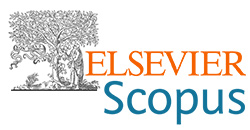Comparison of theoretical and experimental investigation of protonation process of some thiones in acid media
DOI:
https://doi.org/10.5937/zasmat2101009JAbstract
PM3 semiempirical method was used for quantum chemical investigation in order to investigate the electronic properties and to determine the protonation centre in 1,2,4-triazoline-3-thione molecule. Confirmation of protonation center in acid media of investigated compounds was made using the values of atomic charges, as well as, proton affinity values. The results from semiempirical calculations indicated that the protonation center in the thione molecule was the sulphur atom. The behavior of thiones was investigated in mineral acid media using UV spectroscopy. The influence of the strength of the acid and its anion on the protonation process was discussed using three different mineral acids (perchloric, hydrochloric and phosphoric acid) for protonation. The protonation process in perchloric and hydrochloric acid took place in one step, while in phosphoric acid was not finished even when its concentration was to the highest degree. The dissociation constants of protonated forms (pKBH + ) and the solvation parameter m* values were calculated in accordance with "excess acidity" function method (Cox and Yates) using the absorbance data from the experimental and reconstructed spectra (Characteristic Vector Analysis (CVA)). The determined pKBH + values in hydrochloric acid had more negative value than those obtained in perchloric acid media. The pKBH + values were in agreement with the literature data for this class of compounds.Keywords:
1,2,4-triazoline-3-thiones, protonation, dissociation constants, proton affinity, UVspectrophotometry, PM3 semiempirical methodReferences
Albert, A., Serjeant, E.P. (1971) The Determination of Ionization constants: A laboratory manual. London - New York: Chapman and Hal, 2 d edition
Arman-Zubić, L., Perišić-Janjić, N., Lazarević, M. (2000) A study of the behavior of some substituted l,2,4-triazoline-3-thiones in different media.Journal of the Serbian Chemical Society, vol. 65, br. 9, str. 619-630
https://doi.org/10.2298/JSC0009619A
Brown, H.C., Schleyer, P.W.R. (1977) The Non-Classical Ion Problem. New York: Plenum Press
Cetin, A., Geçibesler, I.H. (2015) Evaluation as antioxidant agents of 1,2,4-triazole derivatives: Effects of essential functional groups.Journal of Applied Pharmaceutical Science, 5(06): 120-126
https://doi.org/10.7324/JAPS.2015.50620
Chaudharya, N., Dubeyb, R., Panwarc, H. (2014) Designing, synthesis and pharmacology of some novel 4-{4-(4-bromobenzyliden)amino}piperidin-1-yl)-5-aryl-3-thiol-4H-1,2,4-triazole.Der Pharma Chemica, 6: 115-119
Cox, R.A. (1987) Organic reactions in sulfuric acid: The excess acidity method.Journal of American Chemical Society, 20: 27-31
https://doi.org/10.1021/ar00133a004
Cox, R.A., Yates, K. (1978) Excess acidities: A generalized method for the determination of basicities in aqueous acid mixtures.Journal of the American Chemical Society, 100: 3861-3867
https://doi.org/10.1021/ja00480a033
Cox, R.A. (2000) Advances in physical organic chemistry. Toronto, Ontario, Canada: Department of Chemistry of Toronto
Cox, R.A., Yates, K. (1983) Acidity functions: An update.Canadian Journal of Chemistry, 61: 2225-2243
https://doi.org/10.1139/v83-388
Cox, R.A., Yates, K. (1981) Medium effects in protonation equilibrium studies: Accurate acidity constants using the excess acidity method.Canadian Journal of Chemistry, 59: 1560-1573
https://doi.org/10.1139/v81-230
Davis, T., Geissman, T.A. (1954) Basic Dissociation Constants of Some Substituted Flavones.Journal of the American Chemical Society, 76: 3507-3511
https://doi.org/10.1021/ja01642a045
Dimova, V., Perisic-Janjic, N. (2007) Determination and QSAR study of the dissociation constants of some 4,5-disubsituted-2,4-dihydro-3h-1,2,4-triazoline-3-thiones.Organic Chemistry: An Indian Journal, 3(2): 51-59
Edward, T.E., Wong, S.C. (1977) Ionization of carbonyl compounds in sulfuric acid: Correction for medium effects by characteristic vector analysis.Journal of the American Chemical Society, 99: 4229-4232
https://doi.org/10.1021/ja00455a003
https://doi.org/10.1021/ja00467a603
Eicher, T., Hauptmann, S. (2003) The Chemistry of Heterocycles: Structure, Reactions, Synthesis and Application. Weinheim: Wiley-VCH Verlag, 2 nd ed
Ekiert, R.J., Krzek, J., Talik, P. (2010) Chromatographic and electrophoretic techniques used in the analysis of triazole antifungal agents: A review.Talanta, 82(4): 1090-1100
https://doi.org/10.1016/j.talanta.2010.06.056
Garcia, B., Casado, R.M., Castillo, J., Ibeas, S., Domingo, I., Leal, J.M. (1993) Acidity constants of benzamide and someOrtho-substituted derivatives.Journal of Physical Organic Chemistry, 6: 101-106
https://doi.org/10.1002/poc.610060206
Ikizler, A.A., Abbasoğlu, R., Saltek, N., Şerifova, M. (1997) A Quantum -Chemical Ivestigation on 5,5'-BI(1H-1,2,4-triazole).Turkish Journal of Chemistry, 21: 353-362
Jankulovska, M., Spirevska, I., Ragenovic, K.C. (2006) Behaviour of some newly synthesized substituted 1,2,4-triazoline-3-thiones in sulfuric acid media.Bulletin of the Chemists and Technologists of Macedonia, 25(1): 29-37
Jankulovska, M., Spirevska, I., Šoptrajanova, L. (2006) Determination of the dissociation constants of some newly synthesized derivatives of 1,2,4-triazoline-3-thione in sodium hydroxide media.Bulletin of the Chemists and Technologists of Macedonia, 25(2): 99-106
Karakuü, S., Çoruh, U., Barlas-Durgun, B., Vázquez-López, E.M., Özbaü-Turan, S., Akbuùa, J., Rollas, S. (2010) Synthesis and cytotoxic activity of some 1,2,4-triazoline-3-thione and 2,5-disubstituted-1,3,4-thiadiazole derivatives.Marmara Pharmaceutical Journal, 14: 84-90
https://doi.org/10.12991/201014454
Katritzky, R., Rees, C.W. (1984) Comprehensive Heterocyclic Chemistry-Five-membered Rings with Three or more Heteroatoms, each with their Fused Carbocyclic Derivatives. London: Pergamon Press LTD
https://doi.org/10.1016/B978-008096519-2.00070-9
Lauria, A., Delisi, R., Mingoia, F., Terenzi, A., Martorana, A., Barone, G., Almerico, A.M. (2014) 1,2,3-Triazole in Heterocyclic Compounds, Endowed with Biological Activity, through 1,3-Dipolar Cycloadditions.European Journal of Organic Chemistry, 16: 3289-3306
https://doi.org/10.1002/ejoc.201301695
Öğretir, C., Öztürk, İ.İ., Tay, N.F. (2007) Quantum chemical studies on tautomerism, isomerism and deprotonation of some 5(6)-substituted benzimidazole-2-thiones.Arkivoc, XIV: 75-99
https://doi.org/10.3998/ark.5550190.0008.e09
Perisic-Janić, N., Podunavac-Kuzmanović, S., Vlaović, D. (1994) Electronic spectra and ionization constants of newly synthesized derivatives 1-benzyl-2-amino 5,6dimethyl-benzimidazoles.Journal of Serbian Chemical Society, 59(10): 743-748
Pospieszny, T., Małecka, I., Paryzek, Z. (2012) Synthesis and spectroscopic studies of new bile acid derivatives linked by a 1,2,3-triazole ring.Tetrahedron Letters, 53: 301-305
https://doi.org/10.1016/j.tetlet.2011.11.027
Pospieszny, T., Koenig, H., Kowalczyk, I., Brycki, B. (2014) Synthesis, Spectroscopic and Theoretical Studies of New Quasi-Podands from Bile Acid Derivatives Linked by 1,2,3-Triazole Rings.Molecules, 19: 2557-2570
https://doi.org/10.3390/molecules19022557
Ragenovic, K.C., Dimova, V., Kakurinov, V., Gabor, D.M. (2003) Synthesis of 1-Nonanoyl/octadecanoyl 1-4-substituted Thiosemicarbazides and substituted 1,2,4-Triazoles as biological active compounds.Journal of Hetrocyclic Chemistry, 40: 905-908
https://doi.org/10.1002/jhet.5570400525
Ragenović, K.C., Dimova, V., Kakurinov, V., Gabor, D.M., Buzarovska, A. (2001) Synthesis and antibacterial and antifungal activity of 4-substituted-5-aryl-1,2,4-triazole.Moleculs, 6: 815-824
https://doi.org/10.3390/61000815
Sahu, J.K., Ganguly, S., Kaushik, A. (2014) Synthesis and antimicrobial activity of some novel fused heterocyclic 1,2,4-triazolo [3,4-b][1,3,4] thiadiazine derivatives.Journal of Advanced Pharmaceutical Technology and Research, 5: 90-95
https://doi.org/10.4103/2231-4040.133434
Sharba, A.H.K., Al-Bayati, R.H., Rezki, N., Aouad, M.R. (2005) Synthesis of thiadiazoles and 1,2,4-triazoles derived from cyclopropane dicarboxylic acid.Molecules, 10: 1153-1160
https://doi.org/10.3390/10091161
https://doi.org/10.3390/10091153
Simonds, J.L. (1963) Application of Characteristic Vector Analysis to Photographic and Optical Response Data.Journal of the Optical Society of America, 53: 968-974
https://doi.org/10.1364/JOSA.53.000968
Stewart, J.J.P. (1989) Optimization of parameters for semiempirical methods I. Method.J. Comput. Chem, 10: 209-216
https://doi.org/10.1002/jcc.540100208
Stepanchikova, A.V., Lagunin, A.A., Filimonov, D.A., Poroikov, V.V. (2003) Prediction of biological activity spectra for substances: Evaluation on the diverse sets of drug-like structures.Current Medicinal Chemistry, 10: 225-233
https://doi.org/10.2174/0929867033368510
Tang, R., Jin, L., Mou, C., Yin, J., Bai, S., Hu, D., Wu, J., Yang, S., Song, B. (2013) Synthesis, antifungal and antibacterial activity for novel amide derivatives containing a triazole moiety.Chemistry Central Journal, 7(30): 1-7
https://doi.org/10.1186/1752-153X-7-30
Temple, C., Montgomery, J.A. (2008) The Chemistry of Heterocyclic Compounds, Triazoles 1, 2, 4. in: Chemistry of Heterocyclic Compounds: A Series of Monographs, Hoboken, NJ, USA: John Wiley & Sons, Inc
Thakur, A. (2005) QSAR study on benzenesulfonamide ionization constant : Physicochemical approach using surface tension.Arkivoc, XIV: 49-53
Downloads
Published
Issue
Section
License
Copyright (c) 2021 CC BY 4.0 by Authors

This work is licensed under a Creative Commons Attribution 4.0 International License.






